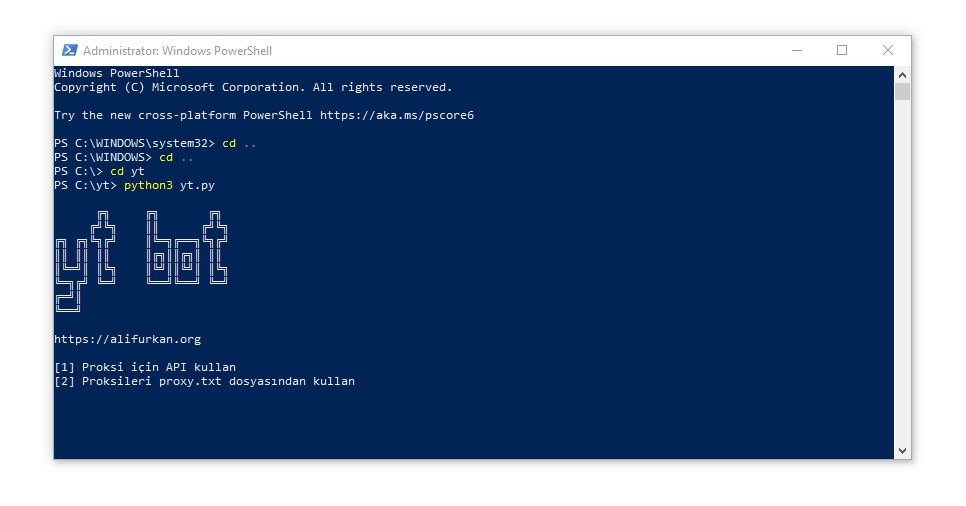

#Python3 ssh proxy password#
password : # Success, status = 0 response = struct. decode ( 'utf-8' ) password_len = ord ( self. recv ( 1 )) assert version = 1 username_len = ord ( self. Python version of authorization looks as follows:ĭef verify_credentials ( self ): version = ord ( self. The status field of 0 indicates a successful authorization, while other values treated as a failure.

The server response should look as follows: version The ulen and plen fields represent lengths of text fields so the server knows how much data it should read from the client. The version field represents the authentication version, which is equals to 1 in our case. Once the client has received the server choice, it responds with username and password credentials. Here the recv function reads n bytes from the client and the struct module helps to pack and unpack binary data using specified format. pack ( "!BB", SOCKS_VERSION, 2 )) def get_available_methods ( self, n ): methods = for i in range ( n ): methods. request ) return # Send server choice self. pack ( "!BB", SOCKS_VERSION, 255 )) self. get_available_methods ( nmethods ) # accept only USERNAME/PASSWORD auth if 2 not in set ( methods ): # close connection self. unpack ( "!BB", header ) # socks 5 assert version = SOCKS_VERSION assert nmethods > 0 # Get available methods methods = self. Here is how the whole process looks in Python:ĭef handle ( self ): # Greating header # read and unpack 2 bytes from a client header = self. The format of the answer looks as follows: version Let's pretend we only support a USERNAME/PASSWORD method. When the SOCKS server receives such message, it should choose an appropriate method and answer back. '80' to X'FE' RESERVED FOR PRIVATE METHODS.Thus the methods field indicates the length of a methods sequence.Īccording to the RFC 1928, the supported values of methods field defined as follows: The methods field consists of a sequence of supported methods by the client. The nmethods field contains the number of authentication methods supported by the client. Here version field represents a version of the protocol, which equals to 5 in our case. The message consists of 3 fields: version When a client establishes a TCP session to the SOCKS server, it must send a greeting message. The ThreadingMixIn can be replaced by ForkingTCPServer, which uses forking approach, that is, it spawns a new process for each TCP session. It gives us an easy way to handle concurrent connections. Every time there is a new incoming TCP connection (session) the server spawns a new thread with SocksProxy instance running inside it. Here the ThreadingTCPServer creates a threading version of TCP server and listens for incoming connections on a specified address and port. Python has a built-in socketserver module, which simplifies the task of writing network servers.įrom socketserver import ThreadingMixIn, TCPServer, StreamRequestHandler class ThreadingTCPServer ( ThreadingMixIn, TCPServer ): pass class SocksProxy ( StreamRequestHandler ): def handle ( self ): # Our main logic will be here pass if _name_ = '_main_' : with ThreadingTCPServer (( '127.0.0.1', 9011 ), SocksProxy ) as server : server. So, first of all, we need to create a regular TCP session handler. The SOCKS protocol is implemented on top of the TCP stack, in such way that the client must establish a separate TCP connection with the SOCKS server for each remote server it wants to exchange data with.
#Python3 ssh proxy full#
Throughout the article, I will be referring the RFC 1928 specification which describes SOCKS protocol.īefore reading this article, I recommend you to clone a completed version of the implementation so you can see the full picture. However, nowadays it is also popular in censorship circumvention and web scraping.

Originally, SOCKS proxies were mostly used as a circuit-level gateways, that is, a firewall between local and external resources (the internet). SOCKS is a generic proxy protocol that relays TCP connections from one point to another using intermediate connection (socks server). I am assuming that you already have a basic understanding of proxy servers.
#Python3 ssh proxy how to#
This article explains how to write a tiny and basic SOCKS 5 server in Python 3.6.


 0 kommentar(er)
0 kommentar(er)
